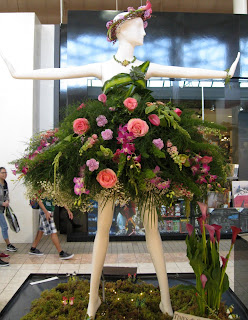After flying across the Pacific from New Zealand we endured a 10-hour layover in San Francisco. We occupied ourselves with: finding a short term hotel room - no such place; a shower - closed for renovations; a place to sleep - the meditation/prayer room but that didn't last long because the dark quiet room was intoxicating when in a jet-lagged state and lying on the floor, as opposed to sitting cross-legged, was forbidden.
The many exhibitions within the airport were a welcome distraction and kept us moving.
Curtain panel, c. 1900 - 1910, USA, cotton
The SFO Museum was established by the Airport Commission in 1980 to humanise the airport environment, share some of the unique cultural life of San Francisco, to provide educational services for the travelling public, and to keep jet-lagged people occupied.
Centrepiece, 1900, Loetz, Austria, glass, bronze
We didn't find all 25 galleries but what we did find certainly worked for a while to distract from our basic needs for sleep, personal hygiene attention, and moving the body.
Jardiniere, 1903, Austria, bronze
When I travel I am always on the lookout for expressions of different art styles in architecture, interior design, and artworks. I am particularly interested in the more recent styles that encompassed more than 2D paintings and sculptures.
The rebellious Arts and Crafts movement at the end of the 19th century in Europe morphing into the Art Nouveau period was the beginning of taking 'art' off the walls and plinths for Europeans.
The motifs on this jardiniere are typical of the period - dragonflies and plants, particularly the stems and leaves caught up in the hair of languid women.
What do you think of the women with their mouths open forming the feet of the dish?
Octopus Chatelaine c. 1900, William B. Kerr & Co., Newark, New Jersey, silver
I had not noticed the octopus motif being used before but with its curvilinear legs it would have been seen as having great design potential if more designers of the time had been familiar with sea life.
Art Deco shop front in Ngatea, New Zealand
My favourite art style is Art Deco, a style that flourished not only in Europe between the world wars but it was the first style that spread around the world. It may have been halted in Europe once WWII started but it continued to develop elsewhere. I love to find Art Deco gems in unexpected places.
It was the first style to unify people rather than separate them. Art Deco concepts were freeing providing a spring point for many different cultures to interpret.
Another reason why I find the Art deco style so fascinating is that it was the first style that permeated all material culture at all economic levels, from grand hotels to this modest shop front (above), from costly wood inlaid furniture to a mass produced milk jug. Everyone could identify with and express themselves through the style.



















































